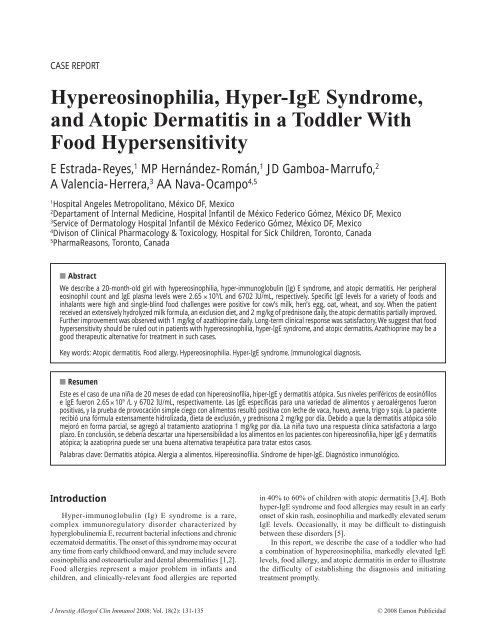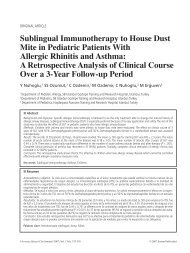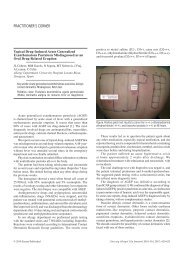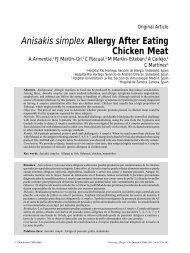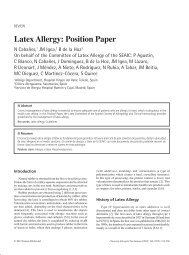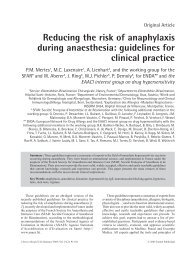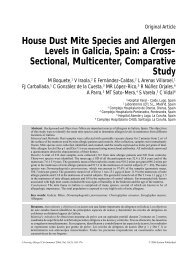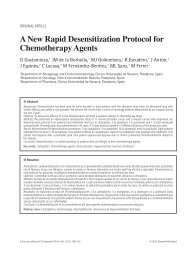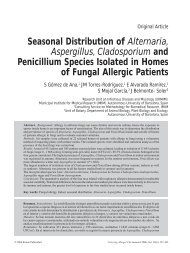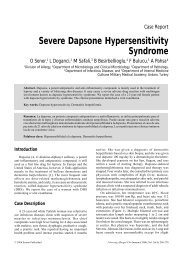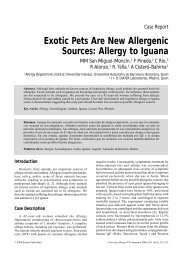Hypereosinophilia, Hyper-IgE Syndrome, and Atopic Dermatitis in a ...
Hypereosinophilia, Hyper-IgE Syndrome, and Atopic Dermatitis in a ...
Hypereosinophilia, Hyper-IgE Syndrome, and Atopic Dermatitis in a ...
Create successful ePaper yourself
Turn your PDF publications into a flip-book with our unique Google optimized e-Paper software.
CASE REPORT<br />
E Estrada-Reyes, et al<br />
<strong><strong>Hyper</strong>eos<strong>in</strong>ophilia</strong>, <strong>Hyper</strong>-<strong>IgE</strong> <strong>Syndrome</strong>,<br />
<strong>and</strong> <strong>Atopic</strong> <strong>Dermatitis</strong> <strong>in</strong> a Toddler With<br />
Food <strong>Hyper</strong>sensitivity<br />
E Estrada-Reyes, 1 MP Hernández-Román, 1 JD Gamboa-Marrufo, 2<br />
A Valencia-Herrera, 3 AA Nava-Ocampo 4,5<br />
1 Hospital Angeles Metropolitano, México DF, Mexico<br />
2 Departament of Internal Medic<strong>in</strong>e, Hospital Infantil de México Federico Gómez, México DF, Mexico<br />
3 Service of Dermatology Hospital Infantil de México Federico Gómez, México DF, Mexico<br />
4 Divison of Cl<strong>in</strong>ical Pharmacology & Toxicology, Hospital for Sick Children, Toronto, Canada<br />
5 PharmaReasons, Toronto, Canada<br />
■ Abstract<br />
We describe a 20-month-old girl with hypereos<strong>in</strong>ophilia, hyper-immunoglobul<strong>in</strong> (Ig) E syndrome, <strong>and</strong> atopic dermatitis. Her peripheral<br />
eos<strong>in</strong>ophil count <strong>and</strong> <strong>IgE</strong> plasma levels were 2.65 �109 /L <strong>and</strong> 6702 IU/mL, respectively. Specifi c <strong>IgE</strong> levels for a variety of foods <strong>and</strong><br />
<strong>in</strong>halants were high <strong>and</strong> s<strong>in</strong>gle-bl<strong>in</strong>d food challenges were positive for cow’s milk, hen’s egg, oat, wheat, <strong>and</strong> soy. When the patient<br />
received an extensively hydrolyzed milk formula, an exclusion diet, <strong>and</strong> 2 mg/kg of prednisone daily, the atopic dermatitis partially improved.<br />
Further improvement was observed with 1 mg/kg of azathiopr<strong>in</strong>e daily. Long-term cl<strong>in</strong>ical response was satisfactory. We suggest that food<br />
hypersensitivity should be ruled out <strong>in</strong> patients with hypereos<strong>in</strong>ophilia, hyper-<strong>IgE</strong> syndrome, <strong>and</strong> atopic dermatitis. Azathiopr<strong>in</strong>e may be a<br />
good therapeutic alternative for treatment <strong>in</strong> such cases.<br />
Key words: <strong>Atopic</strong> dermatitis. Food allergy. <strong><strong>Hyper</strong>eos<strong>in</strong>ophilia</strong>. <strong>Hyper</strong>-<strong>IgE</strong> syndrome. Immunological diagnosis.<br />
■ Resumen<br />
Este es el caso de una niña de 20 meses de edad con hipereos<strong>in</strong>ofi lia, hiper-<strong>IgE</strong> y dermatitis atópica. Sus niveles periféricos de eos<strong>in</strong>ófi los<br />
e <strong>IgE</strong> fueron 2.65�109 /L y 6702 IU/mL, respectivamente. Las <strong>IgE</strong> específi cas para una variedad de alimentos y aeroalérgenos fueron<br />
positivas, y la prueba de provocación simple ciego con alimentos resultó positiva con leche de vaca, huevo, avena, trigo y soja. La paciente<br />
recibió una fórmula extensamente hidrolizada, dieta de exclusión, y prednisona 2 mg/kg por día. Debido a que la dermatitis atópica sólo<br />
mejoró en forma parcial, se agregó al tratamiento azatiopr<strong>in</strong>a 1 mg/kg por día. La niña tuvo una respuesta clínica satisfactoria a largo<br />
plazo. En conclusión, se debería descartar una hipersensibilidad a los alimentos en los pacientes con hipereos<strong>in</strong>ofi lia, hiper <strong>IgE</strong> y dermatitis<br />
atópica; la azatiopr<strong>in</strong>a puede ser una buena alternativa terapéutica para tratar estos casos.<br />
Palabras clave: <strong>Dermatitis</strong> atópica. Alergia a alimentos. Hipereos<strong>in</strong>ofi lia. Síndrome de hiper-<strong>IgE</strong>. Diagnóstico <strong>in</strong>munológico.<br />
Introduction<br />
<strong>Hyper</strong>-immunoglobul<strong>in</strong> (Ig) E syndrome is a rare,<br />
complex immunoregulatory disorder characterized by<br />
hyperglobul<strong>in</strong>emia E, recurrent bacterial <strong>in</strong>fections <strong>and</strong> chronic<br />
eczematoid dermatitis. The onset of this syndrome may occur at<br />
any time from early childhood onward, <strong>and</strong> may <strong>in</strong>clude severe<br />
eos<strong>in</strong>ophilia <strong>and</strong> osteoarticular <strong>and</strong> dental abnormalities [1,2].<br />
Food allergies represent a major problem <strong>in</strong> <strong>in</strong>fants <strong>and</strong><br />
children, <strong>and</strong> cl<strong>in</strong>ically-relevant food allergies are reported<br />
<strong>in</strong> 40% to 60% of children with atopic dermatitis [3,4]. Both<br />
hyper-<strong>IgE</strong> syndrome <strong>and</strong> food allergies may result <strong>in</strong> an early<br />
onset of sk<strong>in</strong> rash, eos<strong>in</strong>ophilia <strong>and</strong> markedly elevated serum<br />
<strong>IgE</strong> levels. Occasionally, it may be diffi cult to dist<strong>in</strong>guish<br />
between these disorders [5].<br />
In this report, we describe the case of a toddler who had<br />
a comb<strong>in</strong>ation of hypereos<strong>in</strong>ophilia, markedly elevated <strong>IgE</strong><br />
levels, food allergy, <strong>and</strong> atopic dermatitis <strong>in</strong> order to illustrate<br />
the difficulty of establish<strong>in</strong>g the diagnosis <strong>and</strong> <strong>in</strong>itiat<strong>in</strong>g<br />
treatment promptly.<br />
J Investig Allergol Cl<strong>in</strong> Immunol 2008; Vol. 18(2): 131-135 © 2008 Esmon Publicidad
Case Description<br />
The patient was a 20-month-old girl with no family history<br />
of atopy. She was delivered uneventfully at 40 weeks of<br />
gestation, with a body weight of 3 kg. Her Apgar score was 9<br />
at 1 m<strong>in</strong>ute <strong>and</strong> 9 at 5 m<strong>in</strong>utes after birth. She was exclusively<br />
breastfed until the age of 4 months. Physical exam<strong>in</strong>ation on<br />
day 3 after birth revealed an ooz<strong>in</strong>g, crusted rash on the face<br />
<strong>and</strong> scalp <strong>and</strong> a generalized maculopapular <strong>and</strong> papulovesicular<br />
rash on her face, scalp, back, neck, chest, <strong>and</strong> abdomen. The<br />
patient was diagnosed with atopic dermatitis <strong>and</strong> her sk<strong>in</strong><br />
lesions were unresponsive to a variety of oral antihistam<strong>in</strong>es<br />
<strong>and</strong> hydrocortisone creams.<br />
The patient was referred to the Hospital Infantil de México<br />
Federico Gómez at the age of 20 months. Growth retardation<br />
was evident (weight <strong>and</strong> length had fallen from the 90th<br />
percentile at birth to below the 5th percentile at the age of 20<br />
months). Dur<strong>in</strong>g the exam<strong>in</strong>ation, we observed clear signs of<br />
atopic dermatitis, <strong>in</strong>clud<strong>in</strong>g ooz<strong>in</strong>g, scratch<strong>in</strong>g, <strong>and</strong> erythema<br />
with excoriations (Figure). Her peripheral eos<strong>in</strong>ophil count<br />
was 2.65 �10 9 /L; <strong>IgE</strong> level, 1548.5 IU/mL; platelet count,<br />
672 �10 9 /L; <strong>and</strong> hemoglob<strong>in</strong> level, 12.2 g/dL. She had a<br />
chronic middle ear <strong>in</strong>fection, dental caries, chronic diarrhea,<br />
pneumonia, hepatosplenomegaly, lymphadenopathy, oral<br />
<strong>and</strong> esophageal c<strong>and</strong>idiasis, <strong>and</strong> hypoalbum<strong>in</strong>emia (3.1 g/dL).<br />
A simple chest radiograph was reported as normal. Systemic<br />
parasitoses secondary to Toxocara species larvae, Fasciola<br />
hepatica <strong>and</strong> Ascaris lumbricoides were ruled out by<br />
microbiological analysis of stool or serology. C<strong>and</strong>id<strong>in</strong> <strong>and</strong><br />
tubercul<strong>in</strong> sk<strong>in</strong> tests were negative.<br />
Her serum immunoglobul<strong>in</strong> titers were IgG, 1060 mg/dL; IgA,<br />
69.9 mg/dL; <strong>and</strong> IgM, 62.4 mg/dL. A test for isohemaglut<strong>in</strong><strong>in</strong><br />
IgM anti-B was positive 1/16. Flow cytometry of peripheral<br />
blood to analyze lymphocyte subpopulations showed the<br />
follow<strong>in</strong>g values: CD3, 48% (limits of normal, 39%-73%);<br />
CD4, 23% (normal, 25%-50%); CD8, 25% (normal, 11%-<br />
32%). The CD4/CD8 ratio was 0.9 (normal, 0.9-3.7) [6].<br />
No malignant cells were found <strong>in</strong> the bone marrow<br />
aspirate. Chemilum<strong>in</strong>escence <strong>and</strong> nitroblue tetrazolium tests<br />
were normal. Liver biopsy showed normal histology. Sk<strong>in</strong><br />
biopsy of affected areas showed nonspecifi c <strong>in</strong>fl ammation<br />
<strong>and</strong> eos<strong>in</strong>ophilic <strong>in</strong>fi ltration. Lymph node biopsy showed<br />
nonspecific <strong>in</strong>flammation. Her karyotype was normal.<br />
Esophageal biopsy identifi ed mild esophagitis, gastritis, <strong>and</strong><br />
duodenitis with eos<strong>in</strong>ophilic <strong>in</strong>fi ltration.<br />
Radioallergosorbent tests (ImmunoCAP, Pharmacia AB,<br />
Uppsala, Sweden) gave the follow<strong>in</strong>g results: > 300 IU/L<br />
for milk <strong>and</strong> > 242 IU/L for chicken egg, Dermatophagoides<br />
pteronyss<strong>in</strong>us, Dermatophagoides far<strong>in</strong>ae, Cynodon dactylon,<br />
Phleum pratense, soy, <strong>and</strong> wheat.<br />
In accordance with European Academy of Allergology <strong>and</strong><br />
Cl<strong>in</strong>ical Immunology recommendations [7], a s<strong>in</strong>gle-bl<strong>in</strong>d<br />
food challenge was performed. Briefl y, for a period of 2 weeks,<br />
the patient took a diet exclud<strong>in</strong>g suspected foods (cow’s milk,<br />
chicken eggs, wheat, nuts, peanuts, soy, etc). The regimen was<br />
adequate for m<strong>in</strong>imiz<strong>in</strong>g nutritional defi ciency. The foods<br />
tested were egg, barley, lentils, milk, nuts, oat, peanuts, soy,<br />
tuna fi sh, cod fi sh, <strong>and</strong> wheat. Each different food was tested <strong>in</strong><br />
a masked form every 48 hours. A total of 1 raw egg (white <strong>and</strong><br />
© 2008 Esmon Publicidad<br />
Severe Food <strong>Hyper</strong>sensitivity <strong>in</strong> a Toddler<br />
A<br />
B<br />
132<br />
Figure. <strong>Atopic</strong> dermatitis <strong>in</strong> a 20-month-old girl with hypereos<strong>in</strong>ophilia<br />
associated with hyper-immunoglobul<strong>in</strong> E syndrome, <strong>and</strong> food<br />
hypersensitivity. Sk<strong>in</strong> lesions (ooz<strong>in</strong>g, scratch<strong>in</strong>g, <strong>and</strong> erythema with<br />
excoriations) were visible all over her body: face, arms <strong>and</strong> trunk (A)<br />
<strong>and</strong> legs <strong>and</strong> feet (B).<br />
yolk) was given to the patient. Successive doses of 0.1, 0.3, 1, 3,<br />
10, 30, <strong>and</strong> 100 mL of fresh pasteurized cow’s milk conta<strong>in</strong><strong>in</strong>g<br />
3.5 % fat were tested. Wheat powder was dissolved <strong>in</strong> water<br />
<strong>and</strong> given <strong>in</strong> a similar dosage regimen until a total amount of<br />
10 g of wheat prote<strong>in</strong> had been provided. The time <strong>in</strong>terval<br />
between doses was 30 m<strong>in</strong>utes. Provocation was stopped if<br />
cl<strong>in</strong>ical symptoms were observed or after reach<strong>in</strong>g the highest<br />
dose. Each food challenge was scored as positive if the tester<br />
observed objective cl<strong>in</strong>ical reactions, <strong>in</strong>clud<strong>in</strong>g urticaria,<br />
angioedema, wheez<strong>in</strong>g, vomit<strong>in</strong>g, diarrhea, abdom<strong>in</strong>al pa<strong>in</strong>,<br />
or exacerbation of eczema, result<strong>in</strong>g <strong>in</strong> a 10-po<strong>in</strong>t <strong>in</strong>crement<br />
J Investig Allergol Cl<strong>in</strong> Immunol 2008; Vol. 18(2): 131-135
133<br />
<strong>in</strong> scores derived from the Scor<strong>in</strong>g <strong>Atopic</strong> <strong>Dermatitis</strong> tool<br />
(SCORAD). Cl<strong>in</strong>ical reactions observed with<strong>in</strong> 2 hours were<br />
defi ned as early reactions whereas those occurr<strong>in</strong>g later were<br />
classifi ed as late reactions [8]. In our patient, s<strong>in</strong>gle-bl<strong>in</strong>d food<br />
challenges gave positive results for cow’s milk, egg, oat, wheat,<br />
<strong>and</strong> soy. The patient received an extensively hydrolyzed milk<br />
formula <strong>and</strong> a diet exclud<strong>in</strong>g milk, gluten cereals (wheat <strong>and</strong><br />
oat), egg, <strong>and</strong> soy.<br />
After approximately 2 months of dietary treatment, only<br />
partial remission of dermatitis had been achieved. Therefore,<br />
oral prednisone at a dosage of 2 mg/kg daily was added to the<br />
treatment. A month later, the girl had an eos<strong>in</strong>ophil count of<br />
0.13 �10 9 /L <strong>and</strong> a platelet count of 458 �10 9 /L, respectively.<br />
However, she still had sk<strong>in</strong> lesions. Prednisone was slowly<br />
tapered off <strong>and</strong> azathiopr<strong>in</strong>e was <strong>in</strong>itiated at a dosage of<br />
1 mg/kg daily.<br />
After 11 months of treatment, the girl was completely<br />
asymptomatic, had an eos<strong>in</strong>ophilic <strong>and</strong> platelet count of<br />
0.74 �10 9 /L <strong>and</strong> 447 �10 9 /K, respectively, <strong>and</strong> had no<br />
hepatosplenomegaly.<br />
Discussion<br />
This child underwent extensive cl<strong>in</strong>ical <strong>and</strong> laboratory<br />
exam<strong>in</strong>ations to establish an association between food<br />
hypersensitivity <strong>and</strong> the triad of hypereos<strong>in</strong>ophilia, hyper-<br />
E Estrada-Reyes, et al<br />
Table 2. Differential Diagnosis of <strong><strong>Hyper</strong>eos<strong>in</strong>ophilia</strong>, <strong>Hyper</strong>-<strong>IgE</strong> <strong>Syndrome</strong>, Food Allergy, <strong>and</strong> <strong>Atopic</strong> Eczema<br />
<strong><strong>Hyper</strong>eos<strong>in</strong>ophilia</strong> [16] <strong>Hyper</strong>-<strong>IgE</strong> Food allergy [17-19] <strong>Atopic</strong> eczema<br />
syndrome [2,5] dermatitis syndrome [4]<br />
Age of onset 5 months (based on 1 report) With<strong>in</strong> a few days or weeks of life From birth to 3 years Early <strong>in</strong>fancy<br />
Gender predom<strong>in</strong>ance Male-to-female ratio 9:1 No gender predom<strong>in</strong>ance Male No gender predom<strong>in</strong>ance<br />
Prevalence 1:200 000 Incidence < 10-6 0.1% to 7% of population 10% to 15% of the<br />
pediatric population<br />
Systemic <strong>in</strong>volvement Cardiovascular, neurological Abscesses, pneumonia, Respiratory (asthma, Between 50 % <strong>and</strong> 80 %<br />
hematological, mucocutaneous rh<strong>in</strong>itis), gastro<strong>in</strong>test<strong>in</strong>al of children develop other<br />
gastro<strong>in</strong>test<strong>in</strong>al, etc c<strong>and</strong>idiasis, connective (vomit<strong>in</strong>g, diarrhea <strong>and</strong> atopic diseases such as<br />
tissue abnormalities, abdom<strong>in</strong>al pa<strong>in</strong>), allergic rh<strong>in</strong>itis <strong>and</strong> asthma<br />
impaired deciduation of<br />
primary teeth<br />
anaphylaxis<br />
Sk<strong>in</strong> <strong>in</strong>volvement Generally, either Rash usually beg<strong>in</strong>s on <strong>Atopic</strong> dermatitis, dermatitis Rash distribution varies<br />
angioedematous <strong>and</strong> the face <strong>and</strong>/or scalp as herpetiformis, gluten, milk with age, <strong>in</strong>volv<strong>in</strong>g cheeks<br />
urticarial lesions. or p<strong>in</strong>k to red papules that <strong>and</strong> soy enteropathies, <strong>and</strong> <strong>and</strong> external surfaces of<br />
erythematous, pruritic become pustules <strong>and</strong> then eos<strong>in</strong>ophilic gastroenteritis, the arms <strong>and</strong> legs <strong>in</strong><br />
papules, <strong>and</strong> nodules break down, exud<strong>in</strong>g pus,<br />
<strong>and</strong> becom<strong>in</strong>g crusted<br />
urticaria, angioedema <strong>in</strong>fancy<br />
Prognosis Depends on the severity Benign if treatment is About 80 % of children Approximately a third of<br />
of ultimate organ damage established early with milk <strong>and</strong> egg allergy children with AD <strong>and</strong> food<br />
Malignant blood disorders will outgrow it by the age allergy outgrow their<br />
are a concern. of 5 y; 20 % of peanutallergic<br />
children will outgrow<br />
the allergy.<br />
cl<strong>in</strong>ical reactivity <strong>in</strong> 1-3 y.<br />
Abbreviations: AD, atopic dermatitis; <strong>IgE</strong>, immunoglobul<strong>in</strong> E.<br />
Table 1. Examples of Causes of <strong><strong>Hyper</strong>eos<strong>in</strong>ophilia</strong> <strong>and</strong> <strong>Hyper</strong>-<strong>IgE</strong><br />
<strong>Syndrome</strong><br />
<strong><strong>Hyper</strong>eos<strong>in</strong>ophilia</strong> a : > 1.5 �10 9 /L <strong>Hyper</strong> <strong>IgE</strong> b : 1875 up to 80 000 IU/mL<br />
Parasitic diseases (eg, ascaris,<br />
fi lariasis, trich<strong>in</strong>osis) <strong>Hyper</strong>-<strong>IgE</strong> syndrome<br />
Infectious diseases, ma<strong>in</strong>ly<br />
associated with<br />
immunodefi ciency syndrome Wiskott-Aldrich syndrome<br />
Drug hypersensitivity Ommen syndrome<br />
Infl ammatory connective tissue<br />
diseases Cornel-Netherton syndrome<br />
Acute <strong>and</strong> chronic eos<strong>in</strong>ophilic<br />
leukemia<br />
Idiopathic hypereos<strong>in</strong>ophilic<br />
syndrome<br />
Abbreviation: <strong>IgE</strong>, immunoglobul<strong>in</strong> E.<br />
a Based on Spry [12]<br />
b Based on Grimbacher et al [2]<br />
<strong>IgE</strong> syndrome <strong>and</strong> atopic dermatitis. S<strong>in</strong>ce the onset of<br />
dermatitis was at the age of 3 days, differential diagnosis of<br />
sk<strong>in</strong> disorders <strong>in</strong> the newborn were considered, particularly<br />
Netherton syndrome, which is characterized by a triad of<br />
symptoms <strong>in</strong>clud<strong>in</strong>g congenital ichthyosiform erythroderma,<br />
J Investig Allergol Cl<strong>in</strong> Immunol 2008; Vol. 18(2): 131-135 © 2008 Esmon Publicidad
trichorrhexis <strong>in</strong>vag<strong>in</strong>ata, <strong>and</strong> atopy. Netherton syndrome is<br />
associated with electrolyte disorders, food-<strong>in</strong>duced anaphylaxis<br />
<strong>and</strong> prol<strong>in</strong>uria [9]. However, our patient did not show the<br />
characteristic cl<strong>in</strong>ical picture of Netherton syndrome.<br />
There are 3 categories of peripheral eos<strong>in</strong>ophilia: fi rst,<br />
the reactive (nonclonal) eos<strong>in</strong>ophilias observed <strong>in</strong> parasitic<br />
<strong>in</strong>festations, asthma or allergies; second, the clonal disorders<br />
of bone marrow; <strong>and</strong> third, idiopathic hypereos<strong>in</strong>ophilic<br />
syndrome, <strong>in</strong> the absence of any clonal abnormality or reactive<br />
cause [10,11]. In the case we have described, most of the<br />
potential causes of hypereos<strong>in</strong>ophilia (Table 1) were ruled out<br />
by the patient’s cl<strong>in</strong>ical course, the negative laboratory results<br />
for parasitic <strong>in</strong>fections, <strong>and</strong> the lack of immunodefi ciency both<br />
<strong>in</strong> peripheral blood tests <strong>and</strong> the bone marrow biopsy.<br />
Although eos<strong>in</strong>ophilia may be present <strong>in</strong> patients<br />
with atopic dermatitis, <strong>in</strong> general, hypereos<strong>in</strong>ophilia has<br />
rarely been reported [12]. We experienced difficulties <strong>in</strong><br />
establish<strong>in</strong>g our patient’s diagnosis due to the fact that this<br />
toddler simultaneously had hypereos<strong>in</strong>ophilia, hyper-<strong>IgE</strong>,<br />
<strong>and</strong> atopic dermatitis. Almost any parasitic <strong>in</strong>vasion of tissues<br />
can elicit eos<strong>in</strong>ophilia. Among neoplastic diseases, Hodgk<strong>in</strong><br />
disease may elicit strik<strong>in</strong>g eos<strong>in</strong>ophilia, whereas it is seen<br />
less often <strong>in</strong> non-Hodgk<strong>in</strong> lymphoma, chronic myelogenous<br />
leukemia, <strong>and</strong> acute lymphoblastic leukemia [10,11].<br />
Acquired <strong>and</strong> congenital immune disorders, often with<br />
eczema, are frequently associated with eos<strong>in</strong>ophilia. For<br />
example, Ommen syndrome is an autosomal recessive form<br />
of severe comb<strong>in</strong>ed immunodefi ciency (SCID) characterized<br />
by erythrodermia, desquamation, chronic diarrhea, failure to<br />
thrive, lymphadenopathy, <strong>and</strong> hepatosplenomegaly [13,14].<br />
Patients may develop fungal, bacterial, <strong>and</strong> viral <strong>in</strong>fections<br />
typical of SCID. These disorders were ruled out <strong>in</strong> our<br />
patient.<br />
<strong>Hyper</strong>-<strong>IgE</strong> syndromes are characterized by the cl<strong>in</strong>ical<br />
triad of high serum levels of <strong>IgE</strong> (> 2000 IU/mL), recurr<strong>in</strong>g<br />
staphylococcal sk<strong>in</strong> abscesses, <strong>and</strong> pneumatocele formation.<br />
Most cases are sporadic, but both autosomal dom<strong>in</strong>ant <strong>and</strong><br />
recessive forms have been described (Table 1). Skeletal<br />
symptoms such as jo<strong>in</strong>t hyperextensibility, scoliosis, osteoporosis,<br />
<strong>and</strong> reta<strong>in</strong>ed primary teeth are associated with the autosomal<br />
dom<strong>in</strong>ant form, whereas the autosomal recessive disease is<br />
ma<strong>in</strong>ly characterized by severe recurrent viral <strong>in</strong>fections.<br />
Severe eos<strong>in</strong>ophilia <strong>and</strong> devastat<strong>in</strong>g neurological complications<br />
are often fatal <strong>in</strong> childhood. However, a mild form without<br />
skeletal or dental abnormalities has recently been described<br />
<strong>in</strong> Mexican patients [1,2]. Children produc<strong>in</strong>g <strong>IgE</strong> antibodies<br />
toward food allergens often also develop <strong>IgE</strong> antibodies aga<strong>in</strong>st<br />
<strong>in</strong>haled allergens [15]. The treatment of hyper-<strong>IgE</strong> syndrome<br />
was recently reviewed [16]. Our patient showed a good<br />
cl<strong>in</strong>ical response to treatment with azathiopr<strong>in</strong>e <strong>and</strong> rema<strong>in</strong>ed<br />
asymptomatic dur<strong>in</strong>g the 11 months of follow-up.<br />
The prevalence of food allergies may vary from 0.3% to<br />
7.5% <strong>and</strong> dairy products for <strong>in</strong>fants that have high allergenic<br />
potential may be derived from different prote<strong>in</strong> sources such<br />
as bov<strong>in</strong>e case<strong>in</strong>, wheat, pork collagen, chicken egg <strong>and</strong><br />
soy [3,17-19]. Both hyper-<strong>IgE</strong> syndrome <strong>and</strong> food allergies<br />
can result <strong>in</strong> the early onset of sk<strong>in</strong> rash, eos<strong>in</strong>ophilia <strong>and</strong><br />
markedly elevated serum <strong>IgE</strong>. Occasionally, it can be diffi cult<br />
to dist<strong>in</strong>guish these 2 disorders [5]. Patients with food<br />
© 2008 Esmon Publicidad<br />
Severe Food <strong>Hyper</strong>sensitivity <strong>in</strong> a Toddler<br />
134<br />
allergy may have gastro<strong>in</strong>test<strong>in</strong>al, respiratory or cutaneous<br />
symptoms [17], <strong>and</strong> they have frequent exacerbations of atopic<br />
dermatitis. In our patient, the immunosuppressive treatment<br />
with azathiopr<strong>in</strong>e <strong>and</strong> dietary restriction successfully controlled<br />
her dermatitis.<br />
In conclusion, patients with hypereos<strong>in</strong>ophilia, hyper-<strong>IgE</strong><br />
syndrome, <strong>and</strong> atopic dermatitis should be evaluated for food<br />
hypersensitivity. To rule out the extensive list of disorders<br />
that may produce hypereos<strong>in</strong>ophilia or a hyper-<strong>IgE</strong> syndrome<br />
may be costly <strong>and</strong> time-consum<strong>in</strong>g <strong>in</strong> comparison to the<br />
prompt evaluation of the patient for food allergies (Table 2).<br />
F<strong>in</strong>ally, azathiopr<strong>in</strong>e may be a good therapeutic alternative<br />
for treat<strong>in</strong>g cases with severe systemic complications of food<br />
hypersensitivity.<br />
References<br />
1. Shemer A, Weiss G, Confi no Y, Trau H. The hyper-<strong>IgE</strong> syndrome.<br />
Two cases <strong>and</strong> review of the literature. Int J Dermatol.<br />
2001;40:622-8.<br />
2. Grimbacher B, Holl<strong>and</strong> SM, Puck JM. <strong>Hyper</strong>-<strong>IgE</strong> syndromes.<br />
Immunol Rev. 2005;203:244-50.<br />
3. Niggemann B, Beyer K. Diagnostic pitfalls <strong>in</strong> food allergy <strong>in</strong><br />
children. Allergy. 2005;60:104-7.<br />
4. Sampson H. Eczema <strong>and</strong> food hypersensitivity. In: Metcalfe DD,<br />
Sampson HA, Simon AR, editors. Food allergy: adverse reactions<br />
to foods <strong>and</strong> food additives. Oxford: Blackwell Science; 2003.<br />
p. 144-57.<br />
5. Hern<strong>and</strong>ez-Trujillo VP, Nguyen WT, Belleau JT, Jeng M,<br />
Conley ME, Lew DB. Cow’s milk allergy <strong>in</strong> a patient with hyper-<br />
<strong>IgE</strong> syndrome. Ann Allergy Asthma Immunol. 2004;92:469-74.<br />
6. Comans-Bitter WM, de Groot R, van den Beemd R, Neijens HJ,<br />
Hop WC, Groeneveld K, Hooijkaas H, van Dongen JJ.<br />
Immunophenotyp<strong>in</strong>g of blood lymphocytes <strong>in</strong> childhood.<br />
Reference values for lymphocyte subpopulations. J Pediatr.<br />
1997;130:388-93.<br />
7. B<strong>in</strong>dslev-Jensen C, Ballmer-Weber B, Bengtsonn U, Blanco C,<br />
Ebner C, Hourihane J, Knulst CA, Moneret-Vautr<strong>in</strong> AD, Nekam<br />
H, Niggemann B, Osterballe B, Ortolani C, R<strong>in</strong>g J, Schnopp C,<br />
Werfel T. St<strong>and</strong>ardization of food challenges <strong>in</strong> patients<br />
with immediate reactions to foods–position paper from the<br />
European Academy of Allergology <strong>and</strong> Cl<strong>in</strong>ical Immunology.<br />
Allergy. 2004:59: 690-7.<br />
8. Niggemann B, Reibel S, Wahn U. The atopy patch test (APT):<br />
a useful tool for the diagnosis of food allergy <strong>in</strong> children with<br />
atopic dermatitis. Allergy. 2000:55:281-5.<br />
9. Hausser I, Anton-Lamprecht I. Severe congenital generalized<br />
exfoliative erythroderma <strong>in</strong> newborns <strong>and</strong> <strong>in</strong>fants: a possible<br />
sign of Netherton syndrome. Pediatr Dermatol. 1996;13:<br />
183-99.<br />
10. Brito-Babapulle F. The eos<strong>in</strong>ophilias, <strong>in</strong>clud<strong>in</strong>g the idiopathic<br />
hypereos<strong>in</strong>ophilic syndrome. Br J Haematol. 2003;121:203-23.<br />
11. Fauci AS, Harley JB, Roberts WC, Ferrans VJ, Gralnick HR, Bjornson<br />
BH. NIH conference: The idiopathic hypereos<strong>in</strong>ophilic syndrome.<br />
Cl<strong>in</strong>ical, pathophysiologic, <strong>and</strong> therapeutic considerations. Ann<br />
Intern Med. 1982;97:78-92.<br />
12. Spry C. The hypereos<strong>in</strong>ophilic syndrome: cl<strong>in</strong>ical features,<br />
laboratory fi nd<strong>in</strong>gs <strong>and</strong> treatment. Allergy. 1982;37:539-51.<br />
J Investig Allergol Cl<strong>in</strong> Immunol 2008; Vol. 18(2): 131-135
135<br />
13. Buckley RH. Disorders of the <strong>IgE</strong> system. In: Stiehm RE, editor.<br />
Immunologic disorders <strong>in</strong> <strong>in</strong>fants <strong>and</strong> children. 4th Edition. WB<br />
Saunders Co, Philadelphia; 1996. p. 409-22.<br />
14. Elder ME. T-Cell immunodefi ciencies. Pediatr Cl<strong>in</strong> North Am.<br />
2000;47;1253-74.<br />
15. Niggemann B, Sielaff B, Beyer K, B<strong>in</strong>der C, Wahn U. Outcome<br />
of double-bl<strong>in</strong>d, placebo-controlled food challenge tests <strong>in</strong> 107<br />
children with atopic dermatitis. Cl<strong>in</strong> Exp Allergy. 1999;29:91-6.<br />
16. Roufosse F, Cogan E, Goldman M. Recent advances <strong>in</strong><br />
pathogenesis <strong>and</strong> management of hypereos<strong>in</strong>ophilic syndromes.<br />
Allergy. 2004;59:673-89.<br />
17. Bock SA. Prospective appraisal of compla<strong>in</strong>ts of adverse<br />
reactions to foods <strong>in</strong> children dur<strong>in</strong>g the fi rst 3 years of life.<br />
Pediatrics. 1987;79:683-8.<br />
18. Muraro A, Dreborg S, Halken S, Host A, Niggemann B, Aalberse R,<br />
Arshad SH, Berg Av A, Carlsen K, Duschen K, Eigenmann P, Hill<br />
D, Jones C, Mellon M, Oldeus G, Oranje A, Pascual C, Prescott S,<br />
Sampson H, Svartengren M, V<strong>and</strong>enplas Y, Wahn U, Warner JA,<br />
Warner JO, Wickman M, Zeiger RS. Dietary prevention of allergic<br />
E Estrada-Reyes, et al<br />
diseases <strong>in</strong> <strong>in</strong>fants <strong>and</strong> small children. Part I: immunologic<br />
background <strong>and</strong> criteria for hypoallergenicity. Pediatr Allergy<br />
Immunol. 2004;15:103-11.<br />
19. Lever R. The role of food <strong>in</strong> atopic eczema. J Am Acad Dermatol.<br />
2001;45:S57-60.<br />
Manuscript received April 13, 2007; accepted for<br />
publication September 4, 2007.<br />
Elizabeth Estrada-Reyes<br />
Consulta de Alergia Pediátrica<br />
Torre Diamante, Apto. 300<br />
Hospital Ángeles Metropolitano, Tlacotalpan Nº 59<br />
México DF 06760, México<br />
E-mail: elizabeth.estradareyes@gmail.com<br />
J Investig Allergol Cl<strong>in</strong> Immunol 2008; Vol. 18(2): 131-135 © 2008 Esmon Publicidad


